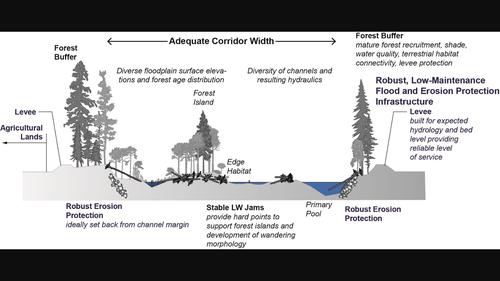Proactive river corridor definition: Recommendations for a process-based width optimization approach illustrated in the context of the coastal Pacific Northwest
引用次数: 0
Abstract
We propose a holistic approach to define a river corridor as the minimum space needed to sustain key river functions based on an understanding of the desired functions of that corridor and the processes governing channel and floodplain formation. Giving such space is a fundamental nature-based solution to river management, as it allows the river to use its own energy to maintain flood conveyance and habitat function. The review of existing river corridor concepts shows that these often focus on one or two potential functions of a river corridor and may not be well suited as tools to optimize eco-geomorphic river function. We argue that evaluating the effects of river corridor width on multiple processes can provide an objective means to optimize delineation in areas where development encroaches onto floodplains and channel migration zones. Key processes are linked to channel migration and include floodplain rejuvenation, emergence of a dynamic patch mosaic of riparian habitat that sustains a functioning large wood cycle, and effects of constriction and confinement on channel dynamics and morphology. Quantification of these processes for an example river shows the most rapid gains for habitat and flood protection values up to the threshold for planform-controlled conditions and an asymptotically reducing rate of gain in function above that threshold. For the example river, the threshold width approaching that asymptote is substantially more than its constrained condition but much less than the width of the floodplain and channel migration zone, offering a compromise for managing rivers with developed floodplains.

积极界定河流走廊:基于过程的宽度优化方法建议,以西北太平洋沿岸地区为背景进行说明
我们提出了一种整体方法,将河流走廊定义为维持河流主要功能所需的最小空间,其基础是对走廊预期功能以及河道和洪泛平原形成过程的理解。给予这样的空间是基于自然的河流管理基本解决方案,因为它允许河流利用自身能量来维持洪水输送和生境功能。对现有河道走廊概念的审查表明,这些概念往往侧重于河道走廊的一两个潜在功能,可能并不适合作为优化河流生态地貌功能的工具。我们认为,评估河流走廊宽度对多种过程的影响,可以为优化洪泛区和河道迁移区的开发划界提供客观手段。关键过程与河道迁移有关,包括洪泛平原的恢复、河岸栖息地动态镶嵌的出现(维持大木头循环的功能)以及收缩和封闭对河道动态和形态的影响。对一条示例河流的这些过程进行量化后发现,在平面形态控制条件的阈值之前,生境和防洪价值的增加最为迅速,而在阈值之上,功能增加的速度则逐渐减小。对于该示例河流而言,接近该渐近线的阈值宽度大大超过其受限条件,但远小于洪泛区和河道迁移区的宽度,这为管理洪泛区发达的河流提供了一个折中方案。
本文章由计算机程序翻译,如有差异,请以英文原文为准。
求助全文
约1分钟内获得全文
求助全文

 求助内容:
求助内容: 应助结果提醒方式:
应助结果提醒方式:


